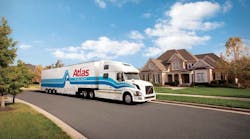Officials of the Department of Homeland Security (DHS) have begun work on a system that would place radiation detectors in rings around major metropolitan areas to prevent nuclear bombs or dirty bomb components from entering a city mainly by truck.
The plan is part of a new layered approach to security that includes replacing the radiation detection devices now at seaports, which are poorly designed for the job. Based on technology long employed by scrap yards and recyclers to ferret out radioactive wastes from hospitals and factories, these units sound an alarm in the presence of radioactive materials. The detectors do not discriminate different types of radiation, however, and often are triggered by naturally occurring and harmless gamma rays in items such as cat litter, ceramic pieces and even bananas.
The technical issue of detection is at the crux of the problem. One of the materials of greatest concern in terms of proliferation — highly enriched uranium — is among the most difficult materials to detect because of its low level of radioactivity. In addition, uranium emits only gamma radiation and can be shielded with as little as a quarter inch of lead. Because so many other products also emit gamma rays, the incidence of false positives is high. The other dangerous material, plutonium, emits both gamma and neutron radiation. Shielding does not stop neutron radiation and, as a result, plutonium can be seen by neutron detectors regardless of the amount of shielding.
Ideally, inspectors would like to check for radiation while cargo is in transit — a typical 10- to 14-day sea voyage affords plenty of opportunity — but stacked cargo makes it nearly impossible to detect radiation in the middle row of containers. To overcome this issue, inspectors have to use fixed or mobile detectors that scan containers individually once they are off-loaded, a time consuming task considering that 11-million containers enter U.S. ports annually, about half of which are loaded on to trucks. Moreover, the General Accounting Office noted in a 2005 report that “environmental conditions, such as high winds and sea spray, can affect equipment's performance and radiation detection stability.”
DHS officials are hoping that a new crop of detectors will solve these problems. In mid-July Homeland Security Secretary Michael Chertoff announced contracts worth $1.16 billion to develop Advance Spectroscopic Portal monitors that can not only detect radiation, but tell what kind. He expects them to be deployed at New York and New Jersey ports by early next year.
At the same time, DHS hopes to place similar detectors at about 150 entry points into New York City, some as far as 50 to 70 miles out. These detectors would be placed at bridges and tunnels and along roadways.
Publicly, Vayl Oxford, director of DHS's Domestic Nuclear Detection office, noted that they have a separate program to address the issue of detecting radiation that is “lightly shielded” by lead or other dense materials. His office had no answer when asked how the program could detect radioactive devices that were “heavily shielded,” which presumably a terrorist organization would do to escape detection. “We don't know that yet,” a spokesperson said, “but I can assure you that we will have a way to detect heavily-shielded radiation sources.”
The spokesperson also said it was too early to discuss procedures for pulling over suspicious trucks for physical inspection or its affect on traffic and delivery schedules. “The testing phase will answer many of these questions.”


